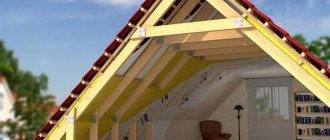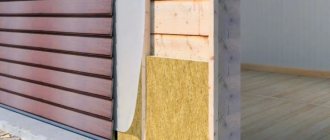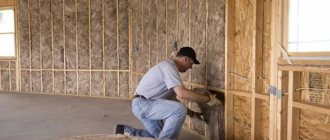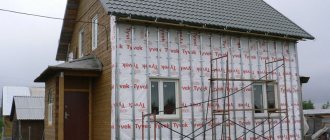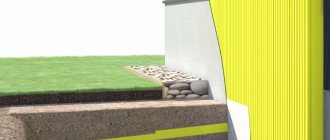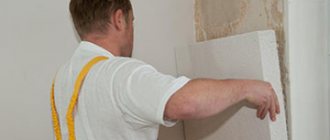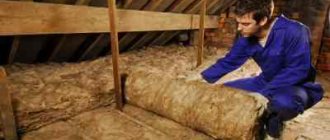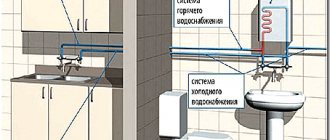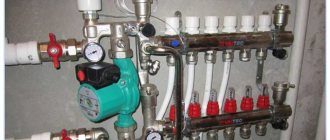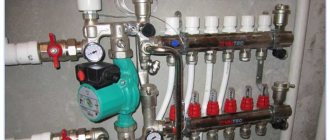Roof insulation - advanced technologies:
- Expanded polystyrene
- Penoplex
- Minvata
- Polyurethane foam
- Penoizol
- Ecowool
- Sawdust
- Expanded clay
How to insulate different types of roofs:
- Mansard roof
- Cold roof
- Attic
- Flat roof
- Garage
Cost of roof insulation
Insulation of the roof of an enterprise
Air heated in a room is known to rise.
If the roof is not insulated, the heat leaves the house and goes outside.
Therefore, roof insulation is one of the most effective heat-saving measures.
Currently, there are many materials and methods of thermal insulation of roofs.
We invite you to further familiarize yourself with the most advanced and effective technologies.
Insulating the roof of a building - basic methods and materials
The concept of “ roof insulation ” means the creation of a thermal insulation layer that prevents heat from escaping outside, that is, keeps it indoors.
For these purposes, materials with low thermal conductivity are used.
As a rule, they have a cellular or fibrous structure and low density.
As a result, most of their volume is occupied by air, which is one of the best heat insulators.
The exception is polyurethane foam, which we will discuss in more detail below.
All options for insulating roofs of buildings can be divided into two types:
- internal - the most common method, which is most often used for thermal insulation of pitched roofs, but can also be used for flat structures;
- external - used exclusively for flat roofs or pitched roofs during their construction or reconstruction.
All insulation materials are divided into three main types:
- polymer - these include regular, liquid and extruded polystyrene foam, as well as polyurethane foam. All these materials have a cellular structure;
- mineral - their most common types are stone wool, glass wool, expanded clay, etc.;
- organic – these include ecowool, sawdust, flax insulation and more.
To make the right choice, consider factors such as:
- thickness and thermal conductivity - selected taking into account climatic conditions in the region;
- service life - modern materials can effectively protect the roof from the cold for decades;
- performance qualities - these include moisture resistance, fire safety, and environmental friendliness.
Summing up
Experienced builders recommend using slab and roll insulation based on basalt wool to insulate the roof. Provided that hydro- and vapor barrier technology is followed, it can last at least 30 years without reducing its basic performance qualities. The use of polystyrene foam increases the fire hazard level of the structure. And the so-called “ecological” insulation materials are unreasonably expensive and not very effective.
If you liked the article, you learned useful information from it, share your opinion with us and recommend our site to your friends.
Roof insulation with foam plastic (expanded polystyrene)
Polystyrene foam, also known as expanded polystyrene, is a white cellular polymer heat insulator.
It is well known to everyone as a packaging material for fragile products.
Foam insulation is sold in the form of rectangular slabs, which come in various thicknesses.
One of the main differences between this material is its density, which is in the range of 15-50 kg/m3.
In pitched roofs, foam plastic is not subject to any mechanical stress, so it is more advisable to purchase slabs with the lowest density.
Firstly, they are cheaper, and secondly, the lower the density, the lower the thermal conductivity coefficient:
- PSB S15 – 0.037 W/(m K);
- PSB S25 – 0.035 W/(m K);
- PSB S35 – 0.033 W/(m K).
If the roof is flat and the insulation is planned to be done from the outside, you will need a grade no lower than PSB S25-PSB S35.
One of the most important advantages of expanded polystyrene is that even high-density grades have a low thermal conductivity coefficient.
In addition, expanded polystyrene has a number of other advantages:
- light weight;
- affordable price;
- easy to machine;
- not subject to rotting.
However, polystyrene foam also has several serious disadvantages:
- most often burns well - many manufacturers, in order to reduce the cost of their products, save on fire retardants, as a result of which the material ignites from a lit match;
- toxicity – the polystyrene foam itself is safe, but when subjected to strong heating and melting, for example during a fire, it releases toxic substances;
- absorbs moisture - as a result, the thermal insulation properties are reduced, so the insulation needs high-quality vapor barrier.
Roof insulation with extruded polystyrene foam (penoplex)
Popularly, extruded polystyrene foam is often called “Penoplex”.
But this is wrong, since Penoplex is a well-known brand under which this material is produced.
Visually, extruded polystyrene foam is easy to distinguish from regular polystyrene foam.
It is usually painted in bright colors and has a uniform rather than granular structure.
In addition, extruded polystyrene foam has a number of advantages, such as:
- strength and durability;
- thermal conductivity 0.028-0.034 W/(m K);
- does not absorb moisture;
- fire safety - manufacturers add fire retardants to the composition, as a result of which the material does not catch fire or has a self-extinguishing property.
Extruded polystyrene foam
Extruded polystyrene foam also has disadvantages:
- quite high price;
- the material “does not breathe” - this can lead to rotting of the rafters in case of poor-quality vapor barrier or its depressurization;
- toxicity when burning - like polystyrene foam, when heated, it releases toxic substances that can lead to poisoning and death.
Extruded polystyrene foam is excellent for both internal and external roof insulation.
From the outside, it can additionally protect the roof from moisture.
There are special slabs on sale for external insulation that allow for a slight roof slope.
As for internal insulation, as when choosing conventional polystyrene foam, it is advisable to give preference to brands with the lowest density.
Roof insulation with mineral wool
Rock wool, which is made from molten rocks, is currently the most common material for roof insulation.
The material is suitable for these purposes in almost all respects.
Visually it resembles glass wool, but has a higher density.
Most often sold in mat form, but low-density brands can also be found in rolls.
You can touch it with your bare hands with virtually no consequences.
Its fibers are more elastic than glass wool.
Special impregnations make it resistant to moisture - drops of water roll off without penetrating into the mat.
In addition, mineral wool has a number of other advantages:
- environmental friendliness - does not contain harmful substances;
- fire resistance - mats not only do not burn, but are also able to protect a wooden structure from fire;
- high vapor permeability - thanks to this, moisture does not accumulate in the rafters and other wooden parts of the rafter system;
- has an affordable price.
The only disadvantage is that the thermal insulation properties of mineral wool are inferior to polymer materials.
Thermal conductivity is in the range of 0.035 – 0.042 W/(m K).
To compensate for this disadvantage, it is necessary to use a thicker layer of insulation.
In addition, impregnations are not able to fully protect the material from moisture.
Therefore, it is necessary to pay maximum attention to waterproofing.
Criterias of choice
The choice of material depends on the preferences of the buyer and his financial capabilities . It is necessary to carefully compare the pros and cons and compare them with the actual conditions in which the house is used.
Pre-postings should be given to insulation with the following parameters:
- resistance to temperature changes and operating range from +40-50 to -60 degrees;
- low specific gravity, allowing the use of a sufficient amount of material even on medium rafters;
- thermal conductivity not higher than 0.050 W/m;
- minimal water absorption;
- resistance to organic pests, including unsuitability for rodents and insects;
- fire safety and non-flammability;
- non-toxic and free of harmful impurities.
Valera
The voice of the construction guru
Ask a Question
Reliable material is not cheap, but its use will fully pay off after 2-3 years of operation. It is after this time that it will be necessary to replace low-quality cheap materials or insulation materials that initially did not meet the specifications.
Roof insulation with polyurethane foam
Polyurethane foam is a unique heat insulator that is applied in the form of liquid foam.
By the way, polyurethane foam, known to almost everyone, is polyurethane foam.
True, for insulation it is used in the form of a two-component composition, that is, it is prepared directly during use.
When applied to an insulated surface, the material dries instantly and gains strength.
One of its main features is that it does not absorb moisture at all.
Unlike the materials described above, polyurethane foam does not require the use of a vapor barrier.
Its advantages, of course, are not limited to this.
Additionally, we highlight the following points:
- exceptional thermal conductivity – 0.019 – 0.028 W/(m K);
- provides a continuous thermal insulation layer - thanks to this, cold bridges are eliminated;
- excellent adhesion – sticks to any type of surface;
- high speed of insulation - the roof of a house with an area of 150 square meters can be insulated in a few hours, since fasteners and installation of a vapor barrier are not required;
- fire safety - fire retardants are added to polyurethane foam, which makes it non-flammable.
However, roof insulation with polyurethane foam has a number of disadvantages:
- It is impossible to insulate the roof on your own - this procedure requires sophisticated equipment, as well as extensive work experience and certain knowledge;
- low operator qualifications negatively affect the efficiency and durability of thermal insulation;
- During the polymerization process, polyurethane foam releases toxic substances into the air.
Note that polyurethane foam (PPU) comes in two types:
- closed-cell - the cells of this material are sealed capsules filled with gas, the thermal conductivity of which is even lower than the thermal conductivity of air. Accordingly, this material is the most effective;
- open-cell – has open cells filled with air (spray foam is this type).
Closed cell polyurethane foam has higher performance.
However, it is necessary to take into account that it costs more.
At the same time, gas leaves the cells over time.
As a result, thermal conductivity increases to the level of open-cell polyurethane foam (PPU).
Thermal insulation with foam insulation
Roof insulation with liquid foam insulation
Penoizol, also known as liquid foam, like polyurethane foam, is applied in the form of liquid foam.
It then polymerizes within a short time.
Accordingly, penoizol has the same advantages as the polyurethane foam described above - it is quickly applied and forms a continuous layer of thermal insulation.
Another important advantage is its relatively low cost.
Thermal insulation properties are somewhat inferior to polyurethane foam - in the range of 0.033 - 0.048 W/m K.
Insulation with liquid foam insulation
As for the disadvantages of penoizol, there are several of them:
- absorbs moisture - needs vapor barrier . True, thanks to vapor permeability, it is able to remove accumulated moisture out;
- toxic during application - therefore requires the use of protective equipment;
- has low mechanical strength - like polystyrene foam, it is a fragile material;
- It is impossible to insulate the roof on your own - it requires special, sophisticated equipment.
Ecowool
To make insulation such as ecowool, waste paper is used. This heat insulator is environmentally friendly with excellent sound and heat insulating properties. But, as you know, cellulose is a flammable material and can be damaged by rodents and microorganisms. For this reason, ecowool is treated with bioprotective compounds and fire retardants.
This material is lightweight and inexpensive. But the installation of roof thermal insulation requires a special approach when it is necessary to install ecowool between the rafters. Closed “boxes” are made from tiled materials, then insulation is blown into them, completely filling the cracks with it.
Among the disadvantages of the heat insulator, it should be noted that it is necessary to prepare for installation and use special equipment.
Thermal insulation of the roof with cellulose insulation
Cellulose insulation, or ecowool, is made from recycled waste paper.
This explains the low cost of this material.
In addition to cellulose, it contains 20% of various additives that prevent combustion, protect the material from biological influences, increase its moisture resistance, and so on.
Please note that there are two types of ecowool:
- dry – is a bulk material, used for insulating horizontal surfaces or frame walls;
- wet-glue – impregnated with glue, which allows you to spray cotton wool on the surface like foam.
It has excellent adhesion, so it can be used to insulate any surface.
Among the advantages of cellulose insulation are:
- environmental friendliness - it’s not for nothing that the material is called “ecowool”, even during the application process it is completely non-toxic;
- the ability to cover surfaces with a continuous layer - as in the case of foam, there are no cold bridges, it is possible to fill any cavities;
- vapor permeability – ecowool removes moisture well;
- does not burn - when exposed to fire, the insulation only smolders and has the property of self-extinguishing;
- practically does not increase the level of thermal conductivity when moisture accumulates.
If mineral insulation, with the accumulation of several percent of moisture, increases thermal conductivity by 10 times, then ecowool can absorb 25% of moisture . At the same time, increase thermal conductivity by no more than 5%.
Roof insulation with ecowool – disadvantages:
- Thermal conductivity is quite low - 0.032-0.042 W/m·K.
- Over time, it decreases in volume - this leads to an increase in thermal conductivity by 20-30 percent. Therefore, it is necessary to use ecowool with an appropriate reserve.
- It takes a long time to dry - when applied using the wet-adhesive method, drying may take several days.
- It is impossible to carry out insulation yourself - special equipment is required to apply wet-adhesive ecowool.
Thermal insulation with sawdust
Foam concrete
This material is used when it is necessary to solve the problem of how to insulate the roof of a private house with a flat roof.
Foam concrete is made from:
- cement;
- concrete;
- sand;
- means for the formation of pores.
The use of foam material results in the creation of strong and durable roof insulation. Since foam concrete has a low density, it does not place high loads on the supporting frame and retains heat well.
Advantages of foam concrete:
- environmental friendliness;
- vapor permeability;
- fire safety.
To lay foam concrete, a special mobile installation is used. As a result, the insulation layer should be 3–15 centimeters.
Roof insulation with sawdust
Sawdust is the cheapest and most environmentally friendly thermal insulation material.
It has fairly low thermal conductivity.
This indicator is at the level of 0.070–0.093 W/mK.
Sawdust is used to insulate horizontal surfaces, for example, floors.
They simply fall asleep between the beams.
If the floor is concrete, you can use logs on which the flooring will subsequently be laid.
You can also use sawdust to insulate the roof slopes from the outside during its installation.
Insulation with sawdust
To do this, it is necessary to secure a vapor barrier from the inside and make a lining from boards or other material.
Please note that only well-dried sawdust is suitable for insulation.
No traces of rot.
Their main disadvantage is flammability and susceptibility to biological influences.
To eliminate this drawback, you can make a mixture consisting of the following components:
- 85% sawdust;
- 10% lime;
- 5% gypsum paste mixture.
Wood sawdust
Long before the advent of modern thermal insulation materials, sawdust, a wood waste product, was especially popular when it was necessary to insulate the roof of your own home. They are environmentally friendly, hypoallergenic, but flammable, which must be taken into account when choosing an insulation option. In addition, rodents love to live in them, and sawdust is also susceptible to rotting.
This bulk material does not insulate the roof structure, but only the ceiling. Ecowool can be used similarly. By laying sawdust in an even layer, the ceilings of residential premises in their own homes are effectively insulated.
In order to enhance the thermal insulation properties, sawdust is mixed with clay and the attic floor is treated. Their use is possible only on the condition that the attic space will not be used.
The correct choice of insulation and high-quality arrangement of the roofing pie allows you to provide a microclimate favorable for its residents in a private household throughout the year, and save on heating in winter.
Roof insulation with expanded clay
Expanded clay is a bulk material made in the form of granules, so its scope is the same as that of saws.
This material is obtained by firing clay with special additives.
During heat treatment it foams.
Due to its porous structure, it has a thermal conductivity of about 0.16 W/mK.
Among the positive qualities of expanded clay are:
- environmental friendliness - there are no toxic substances in the composition;
- vapor permeability – removes accumulated moisture well;
- low cost - is one of the cheapest bulk thermal insulation materials;
- fire resistance – expanded clay does not burn and is able to protect a wooden structure from fire;
- biostability - the material does not rot and is not affected by fungi.
Thermal insulation of the roof with expanded clay
The main disadvantage of expanded clay is its high or relatively high thermal conductivity.
To achieve the desired result, it must be used in a thick layer.
Insulation of gables can be carried out both from the outside and from the inside.
From the outside they are insulated using the same technology as the facade.
For insulation from the inside, a frame is mounted in the form of racks, between which slabs or mats are laid.
Otherwise, the technology is the same as for insulating slopes.
Features of attic roof insulation
The highest demands are placed on the insulation of the attic roof, since it most often serves as a living space.
Therefore, the main characteristics that a thermal insulation material must have are environmental friendliness and fire safety.
Basalt wool has all these qualities.
Less commonly used for these purposes are materials such as:
- polyurethane foam;
- expanded polystyrene;
- ecowool.
As a rule, the thickness of thermal insulation for a residential attic in central Russia is at least 200 mm.
In regions where winter temperatures often exceed -25 degrees, thicker insulation should be used - 250 mm.
The insulation technology depends on the type of material.
Foam materials or ecowool are sprayed in a continuous layer on all surfaces of the structure.
Board materials and mats are used using the following technology:
- Superdiffuse film is used as roofing waterproofing, allowing moisture to escape to the outside;
- the space between the rafter legs is filled with expanded polystyrene. The gaps in the insulation are filled with adhesive foam;
- A vapor barrier film is attached to the side of the room. The joints are taped with double-sided special tape, which allows you to create an absolutely sealed contour;
- wooden slats are mounted on top of the vapor barrier, to which the sheathing is attached.
Not only the comfort in the room, but also the durability of the rafter system depends on compliance with the technology.
How to properly ventilate a roof
- The area of exhaust and supply openings must be determined taking into account certain parameters, which include the volume and concentration of removed vapors, etc., which in practice is not always possible to do. Therefore, they usually use existing empirical findings. 2. The height of the ventilation gap between the base of the roof and the insulation must be at least 5 cm. It directly depends on the length and angle of inclination of the roof slopes. 3. The flow of air is organized both along the entire eaves and in local places - with the help of ventilation grilles that cut into the lining of the eaves overhang. 4. The total area of exhaust ventilation openings installed only at the highest point of the roof must be no less than the area of the supply openings for each slope. Exhaust devices are ventilation hoods for hipped roofs, ventilation ridges, roof aerators, etc. You can use both ready-made (store-bought) devices and those made by yourself. https://www.youtube.com/watch?time_continue=3&v=uzNCsJO2k6w
Insulation of a cold roof
A cold roof is any pitched roof whose slopes are not insulated.
In this case, the space between the slopes and the ceiling itself serves as thermal insulation.
But, since the temperature in the attic is much lower than in a heated house, heat loss is still at a fairly high level.
To avoid them, you should insulate the cold roof, namely, thermal insulation of the ceiling.
Absolutely any material that we mentioned above is suitable for this.
The technology depends on the type of overlap.
If beams serve as the load-bearing element, thermal insulation is carried out as follows:
- the structure is covered with a layer of vapor barrier, which should form a sealed contour;
- then the space between the beams is filled with any heat insulator;
- A layer of waterproofing film and flooring are laid on top of the insulation and beams.
If the floor is a solid slab, insulation can be done either in the manner described above using logs, or by pouring screed.
The principle is quite simple - polystyrene foam slabs are laid on the ceiling.
A concrete screed is poured on top of them.
As a result, the roof remains cold, but at the same time, virtually no heat leaves the room through the ceiling.
Attic insulation
The cheaper way to insulate a house from the outside
The cheapest option for home insulation is polystyrene foam. When using it to insulate walls outside the house, it is necessary to maintain the thickness, since if the thickness of the foam is insufficient, then in the cold season the walls will freeze and be blown through.
For high-quality insulation, a 5 cm sheet of polystyrene foam is enough, and more is possible. In practice, it has been shown that for our climate, 5 cm of foam thickness is enough to insulate walls, but this is provided that the walls do not face the north side. If the walls of the house are on the north side, then the best option would be to insulate them with foam plastic with a thickness of 100 mm.
Please note that polystyrene foam is the most budget-friendly insulation option and at the same time has maximum thermal insulation efficiency. The best cheap and effective material for outdoor work is polystyrene foam. Thin, inexpensive foam is ideal for the ceiling.
Polystyrene foam has many advantages
Polystyrene foam also has negative qualities, namely:
In terms of strength, it is very weak and no putty will add it.
And due to such low strength, foam plastic is easily subject to mechanical damage. Despite the fact that insulation with this building material is very easy, the installation of foam plastic itself has many nuances. The main nuance of installation is not observing the spacing of the seams, and because of this, within a week many cracks may appear on the walls. This situation can also arise on the corner of a house.
These are not all the negative aspects of insulating material. There are still disadvantages, but the insulation has many more positive aspects, and this makes this material popular among consumers. In any case, this material is the “warmest”, which attracts buyers.
Attic insulation
Attic insulation involves thermal insulation of slopes, ceilings and gables.
The slopes are insulated from the inside in the same way as an attic roof.
The only thing is that if the procedure is carried out at the stage of roof installation, it can be performed from the outside.
In this case, the insulation technology looks like this:
- on the inside, a vapor barrier and plank sheathing are attached to the rafters;
- on the outside, insulation is placed in the space between the rafters on the filing;
- then the roof is covered with a diffuse film and the roofing material is installed.
The insulation of the floor is carried out according to the scheme described above.
Flat roof insulation
Flat roof insulation
A flat roof is usually insulated from the outside.
For these purposes, polymer slab insulation or mineral mats are used.
The technology looks like this:
- a layer of vapor barrier is laid on a well-dried and cleared of debris flat roof;
- Insulation boards are laid on top. As a rule, they are laid in two layers, overlapping the joints, which eliminates cold bridges;
- A waterproofing film is laid on top of the insulation and a screed is poured, which is also waterproofed.
Instead of a screed, a special roofing membrane can be used, which is laid on top of the insulation.
Her seams are sealed.
A flat roof can also be insulated from the inside.
For example, covering it with polyurethane foam, liquid foam or ecowool.
In order not to involve equipment in the work, thermal insulation can also be made using slab materials.
If, for example, the roof is formed of concrete slabs, the insulation technology looks like this:
- expanded polystyrene or mineral wool is glued to the concrete surface with special glue;
- additionally, the insulation is fixed with disc-shaped dowels;
- A reinforced fiberglass mesh is glued to the insulation and covered with a continuous layer of glue, which acts as rough plaster.
If the roof has a rafter structure, it can be insulated in the same way as a gable or attic roof.
Garage roof insulation
Glass wool
This well-proven thermal insulator has technical characteristics similar to mineral wool. In the production of glass wool, glass melt is used.
It is sold on the construction market in rolls and in the form of slabs. This is an environmentally friendly insulation material with good soundproofing qualities. When installing a heat-insulating layer using glass wool, roofers use protective clothing and special equipment and follow safety precautions so as not to cause harm to health.
Before insulating the roof of a private house using mineral wool, you need to select a vapor barrier material, and at the same time, glass wool slabs may already have a foil coating on the outside - its presence simplifies the installation of the thermal insulation layer.
Garage roof insulation
The process of insulating a garage roof does not differ in any special ways.
It all depends on the type of its design.
If the roof is gable, you can only insulate the ceiling using one of the methods described above.
Thermal insulation of a flat roof can be done both outside and inside according to the standard scheme.
Roof insulation - price
The cost of roof insulation depends on the type of material chosen.
Below are the prices current for 2018-2019:
- mineral wool – from 100 rub./m2;
- liquid foam - from 2200 rub./m3;
- ecowool - from 160 rub./m2;
- expanded clay - from 1950 rub./m3;
- polyurethane foam - from 400 rub./m3;
- polystyrene foam - from 150 rub./m2.
Consumer Reviews
Review of Linerock “Light effect” insulation:
More details on Otzovik: https://otzovik.com/review_1208058.html
Linerock Light effect
Review of ISOROC mineral wool thermal insulation:
More details on Otzovik: https://otzovik.com/review_7134354.html
mineral wool ISOROC
Another review about ISOROC mineral wool thermal insulation:
More details on Otzovik: https://otzovik.com/review_3951910.html
Review of Penoplex thermal insulation boards:
More details on Otzovik: https://otzovik.com/review_3959072.html
Penoplex slabs
Penoplex slabs
Review of ISOROC mineral wool thermal insulation:More details on Otzovik: https://otzovik.com/review_5193087.html
Manufacturers of thermal insulation materials
The effectiveness of thermal insulation depends not only on compliance with the technology, but also on the quality of the insulation.
When choosing insulation, it is advisable to give preference to products from well-known brands, such as:
Penoplex
Penoplex
Penoplex is a Russian manufacturer that has been producing extruded polystyrene foam since 1998.
Currently it is one of the largest domestic companies.
The products are of high quality, environmental friendliness and durability.
TechnoNIKOL
TechnoNIKOL
TechnoNIKOL is another Russian company that produces high-quality extruded polystyrene foam, mineral wool, hydro-vapor barrier and other insulation materials.
The brand is known not only in Russia, but also far beyond its borders.
In particular, we have our own production sites in Italy, Great Britain, the Czech Republic and many other countries in Europe and the CIS.
Paroc
Paroc
Paroc is one of the largest mineral wool producers in Europe.
The office is located in Finland, but the products are sold in markets of more than 40 countries.
The history of the company goes back more than 80 years.
During this time, the Paroc brand has become synonymous with high quality.
Isover
Isover
Isover is a famous French brand that produces mineral wool known throughout the world.
The Saint-Gobain company, which owns the Parok brand, was founded 350 years ago. Currently, it has representative offices in more than 60 countries around the world.
The products are famous for their high quality and the most modern technologies used in their production.
Knauf
Knauf
Knauf is a German company founded in 1932 that needs no introduction.
It produces a huge amount of building materials.
In particular, thermal insulation materials are also available on the market - polystyrene foam for insulating walls, floors and other surfaces.
Rockwool
Rockwool
Rockwool is an international company headquartered in Denmark.
The company produces stone wool.
The history of Rockwool began in 1909.
Over the 110 years of its existence, it has opened production sites in 28 countries.
Products are supplied to more than 100 countries around the world.
It is very popular in Russia.
Choose by cost
The cost of insulation changes very quickly. Therefore, as an example, we present a small plate with the cost of some popular insulation materials.
| Mineral wool | Amount in a package | Thickness, mm | Cost in rubles | Cost in dollars |
| TechnoNIKOL Greenguard | 4 | 100 | 380 rubles | 6,5 |
| Paroc Extra | 8 | 100 | 1000 rubles | 17,2 |
| Isover Classic cooker | 10 | 100 | 525 rubles | 9 |
| Izovol St-50 | 4 | 100 | 400 rubles | 6,9 |
| Styrofoam | Amount in a package | Thickness, mm | Cost in rubles | Cost in dollars |
| Knauf Therm | 10 | 100 | 2200 rubles | 38 |
| TechnoNIKOL Carbon Eco | 4 | 100 | 2600 rubles | 45 |
| Penoplex Comfort | 18 | 20 | 1200 rubles | 20,6 |
Blowing polyurethane foam will cost 200-300 rubles per square meter (labor and material). Ecowool will cost 3000-4000 rubles per cubic meter. The cheapest insulation is probably sawdust, 300-500 rubles per cubic meter. Using the above figures, you can calculate the approximate cost per square meter of insulation.
